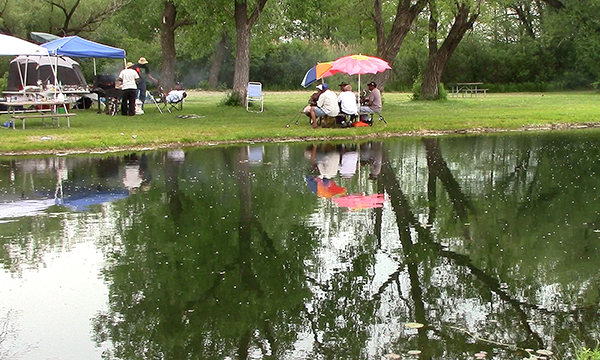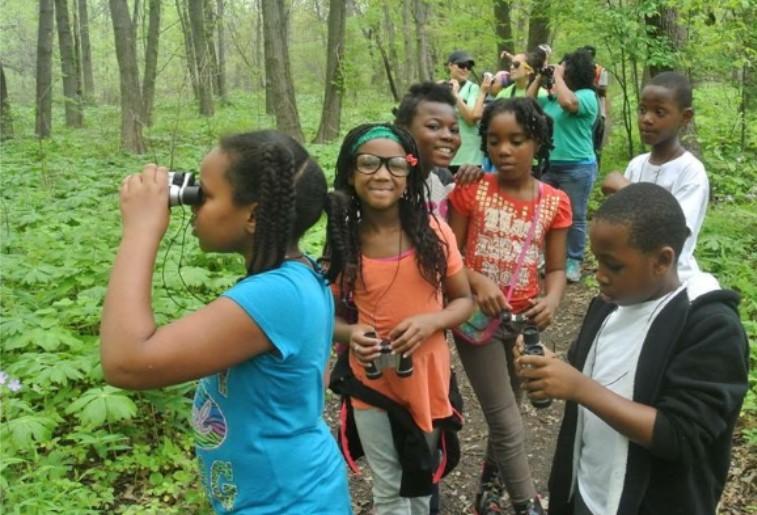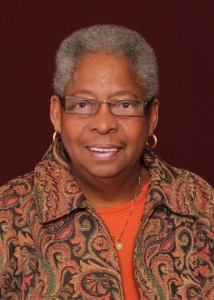
Urban camping has spread its wings at the William W. Powers State Recreation Area.
The 580-acre park is the only State Park in the City of Chicago. The recreation area is at 130th Avenue O on the far southeast side of the city. The park’s jewel is the 419-acre Wolf Lake that borders Hammond, Ind., and although it has been described as a “hidden gem,” nearly half a million people visit annually.
Interim Site Superintendent Levi Bray said that at least 60 per cent are minority outdoors enthusiasts, which skews up from national camping demographics. There’s no camping at the park but there’s ample room for bird watching, boating, biking and picnicking. Fishing is a big draw as the lake is filled with bass, catfish, northern pike, hybrid muskie and walleye. Bird watchers can catch blue jays, finches, orioles,
mallards and cardinals.
And there’s Pee Wee the monk parakeet.

Local lore says a few South American parrots migrated roughly 30 miles from the Hyde Park neighborhood of late Chicago Mayor Harold Washington. Pee Wee now lives in the park’s business center.
“Someone said Harold Washington introduced these birds to Hyde Park,” Bray explained during a late August interview. Bray began his career with the Illinois Department of Natural Resources (IDNR) in 1990 as a Site Technican. “Back then we had hundreds of the parrots here,” he said. “They blew the transformers. (The monk parakeet likes to build nests adjacent to warm transformers.) It killed them all, except for a couple.”
In January, Bray was assigned as the Interim Site Superintendent at William W. Powers. He had been Ranger at the I&M Canal State Park near Joliet. “When I came back I saw Pee Wee was still there,” he said with a laugh.
Mayor Washington lived in the Hampton House condo building, 53rd neat South Shore Drive, across the street from a small park that included a colony of monk parakeets. He called the birds a “good luck
tailsman.” After his death in 1987, the USDA (U.S. Department of Agriculture) tried to remove the parakeets. Hyde Park residents created a defense committee and threatened a lawsuit. The birds won.
Remember when conflict was so beautiful?

Abraham Lincoln visited the future William W. Powers park and Mary Todd Lincoln nearly drowned in Wolf Lake in a spot located near the visitors center.
The State of Illinois acquired an 160-acres parcel of the future park in 1947 and in 1965 the Illinois General Assembly named the area after 1920s Chicago alderman William W. Powers. He used the cottonwood and willow tree site for picnics to feed the needy during the Great Depression.
“There’s a lot of history here,” Bray said. “Actually until I came here for the job, I didn’t even know this existed. We draw a lot of Hispanics. African-Americans. Lots of Polish.”
Wolf Lake is a deep Chicago melting pot.
In 2014 the Coleman Company, Inc. and the Outdoor Foundation compiled the “2014 American Camper Report” through 19,240 online interviews. Their research found that eight per cent of American campers were Hispanic, six per cent were African-American and four per cent were black. (The average age of a camper was 32.)
New minority camping organizations are emerging such as Outdoor Afro, based in Oakland, Ca., Wild Indigo and the National African-American RVers Association (NAARVA), the fastest growing RV organization in the country. NAARVA was founded in 1993 and has nearly 2,000 members.
The North Carolina-based organization hosts annual rallies that includes seminars, fishing, cake walks, pot luck dinners and worship service.
“For the last three to four years, we’ve been growing four to five per cent a year,” said NAARVA president Carolyn Buford in a phone conversation from her Kansas City, Mo. home. “We’ve had a lot of young retirees who have moved to the southern region; Florida, Alabama and Mississippi. Our members have motor homes, travel trailers and fifth wheels. The only requirement is that you have cooking and bathroom facilities in your RV.”

Buford’s father was an avid camper. Her husband Luther is a retired Kansas City law enforcement officer. She is retired from information management at AT&T. Carolyn and Luther bought their first unit in 1969. It was a Holiday Rambler travel trailer. They now own a motor home.
“One reason we joined NAARVA is that we had been to a lot of states and we had seen very few minorities,” she said. “It was interesting to hear about an organization comprised of 98 per cent minorities. Even as we travel today, we don’t see a lot of minorities on the road. NAARVA has local clubs and we see more minorities when we camp with our local clubs. We go away for the winter and even though we’ve been going to this particular park for six or seven years people still look at us like, ‘Where did you come from?’ ”
Supreme Court judge Clarence Thomas is an avid camper who can be found setting up shop in Wal-Mart parking lots. “We contacted him we know he bought an RV,” Buford said. “As far as we know, he’s still camping in his RV (he once had 40-foot Prevost).” Baseball Hall of Famer Bob Gibson is a well known African-America RV enthusiast. The Bufords purchased their motor home from Bill Thomas Camper Sales in Wentzville, Mo., the same St. Louis area store that serves Gibson.

Bray said, “Lately I’ve been seeing more African-American people camping. But as a kid I never thought about camping. One of my wife’s friends, they’re big (African-American) family campers. He was in the
Army and I think that’s how he got into it. Every Labor Day my wife’s cousin and their family go to Starved Rock (outside of Chicago.) Its about 50 people.”
Bray, 60, grew up on a farm between West Memphis and Little Rock, Ark. Bray was speaking the day after the park’s “Aquatic Pet Take Back” event. “This was for reptiles and goldfish,” he said. “No one showed up. I guess no one wanted to turn in anything. But in the past there’s been instances when people brought in alligators. Maybe an iguana is not quite what someone wanted, so they can turn them in here.”
The park is operated under the auspices of the Illinois Department of Natural Resources. It is open year round. Bray said, “Starting in October we’ll have duck and geese hunting. This park is really a nice place. The (Cook) county actually just put a campground about 15, 20 minutes south of us.”
In the summer of 2015 the Forest Preserve of Cook County opened Camp Sullivan, 14630 S. Oak Park Ave. in Oak Forest. The park had been used for scouting activities but was turned over to families and groups for the first time in 50 years. Camp Sullivan is part of the 612-acre Tinley Creek Woods and offers tent camping, bunkhouse rental and a vintage red barn with a climbing wall. Also, in 2015 Camp Shabbona Woods, 15810 S. Torrence Ave. in South Holland opened with nature trails, mulch tent pads, three season cabins, and yes, even bathrooms and showers.
The Aug. 27 New York Times Travel section reported the explosion in camper culture. Writer Stephanie Rosenbloom said that about 13 million households in the United States planned to camp more this year than last year, according to research conducted by Kampgrounds of America. More than a million new households have started camping since 2014.
Such massive growth has to embrace the diversity that gives America her wings.